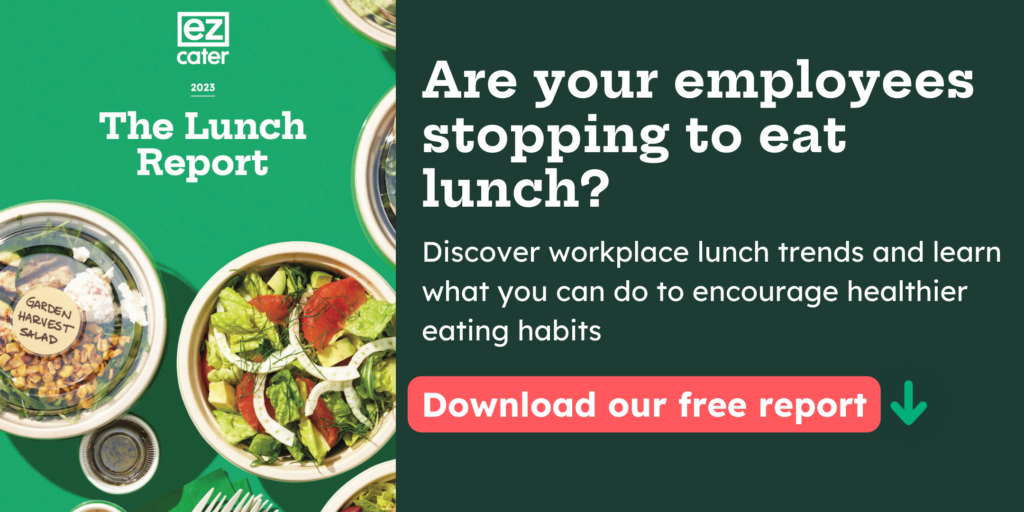There’s no question that the pandemic changed the way people think about work—what they do, who they do it for, and where and when they do it. Even how they eat. As Martine Ferland, CEO of employee benefits consulting firm Mercer said recently , “A new culture has been set in terms of the deal between employees and their employer.”
One thing that’s taken on new meaning in today’s re-imagined workplace? The much appeciated work perk of providing free lunch at work.
In ezCater’s new Lunch Report, we interviewed 1,000 workers and found that catered lunches are not only valued by employees, they actually have the power to encourage employees to work on-site more often. In fact, The majority of respondents (65%) are willing to plan their in-person office visits based on whether or not complimentary catered lunch is being offered that day. To understand how the lunch at work perk makes a real difference, let’s look at a few of our key findings.

Free Lunch Ranks Higher Than Other Employee Perks
It’s often said that the way to a person’s heart is through their stomach, but many people still underestimate the power of the lunch-at-work perk. Our survey, however, makes it crystal clear that people love a free lunch (even if they have to go to the office to get it).
In fact, 44% of employees ranked free lunch in their top two work perks (only getting five extra vacation days was ranked higher). And 1 in 5 said free lunch was the most important perk, beating out:
- Reimbursement for transportation (16%)
- Weekly happy hours (12%)
- Gym reimbursement (10%)

Free Lunch at Work Motivates People to Work On-Site
It won’t surprise anyone who’s left their cubicle with the promise of a cupcake to learn that free lunch at work can be a very persuasive offer.
- Nearly 1 in 4 employees (23%) said they would return to the office in-person full time if free, catered lunches were available.
- 20% said they would plan on traveling to the office 3-4 days a week to reap the benefits of free meals.
- 15% were willing to commute in for lunch 1-2 days out of their week for free lunch at work.
- The majority of respondents, 65%, are willing to plan their in-person office visits based on whether or not complimentary catered lunch is being offered that day.
Clearly, the promise of a free lunch holds enough appeal to lower employee resistance to returning to an in-person working situation.

“Lunch-flation” Is On Everyone’s Minds
Part of what makes employee lunch so appealing is that it helps ease the pain of rising food costs, or “lunch-flation.”
Regardless of their age, title, or job setting, 52% of survey respondents spend $11 or more per lunch when they buy lunch out. Free lunch at the office represents substantial cost savings at the individual level.
While the rising costs of dining out for lunch affect everyone, it seems that the younger generations–who are less likely to bring lunch from home, and more likely to outspend their older counterparts when eating lunch out–are among the hardest hit:
- Only 9% of Gen Z bring lunch from home
- 73% of Gen Z and 68% of Millennials buy lunch at least 2 times a week, more so than their older co-workers (Boomers (44%), Gen X (58%))
Younger Generations Are Especially Motivated By Free Employee Lunch
Even though only 1 in 3 GenZ (29%) and Millennials (35%) take a lunch break 5 days a week, these younger employees are still more motivated by lunch at work than their older counterparts:
87% of Gen Z said they’d work onsite “more frequently” followed by 75% of millennials, and 58% of Gen X, with Boomers in last at 57%.
This information is especially important since Gen Z will dominate the workforce by 2030 (which is not that far away). Savvy employers will take steps now to level up their food-at-work game so they can make the most of folks’ interest in the employee lunch benefits.
Lunch: The Meal With The Power To Bring People Back Together
There’s nothing easy about getting back into the swing of things after the long-term crisis of a pandemic. Many experts agree that COVID-19 was a turning point for how we work, and the so-called Great Resignation seems to reflect that opinion.
But sometimes it’s the little things that can make the biggest difference.
As a MetLife report on the rise of the “whole employee” pointed out, the power dynamics between employees and employers have shifted. Employee loyalty has declined almost a full 10 percentage points since the beginning of the pandemic. Because of this, employers must get creative about how they meet employees where they are in order to boost job satisfaction. Providing lunch at work can be a valuable tool in an employer’s back-to-the-office toolkit.
To cite another example featuring a big, powerful company, a recent New York Times story highlighted how Microsoft made food a central part of their return-to-office festivities, “And, of course, there was free food and drink: pizzas, sandwiches and specialty coffees. Microsoft paid for food trucks with offerings including fried chicken, tacos, gyros, Korean food and barbecue.”
But perhaps most enlightening was this tweet from a Microsoft employee:
Are You Ready To Take Your Employee Lunch Game To The Next Level?
To read all of our survey results, check out our full report, The Lunch Report: Why Food at Work Matters.







